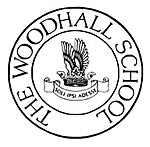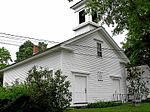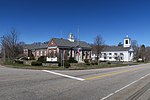Bellamy-Ferriday House and Garden
Bethlehem, ConnecticutConnecticut LandmarksHistoric district contributing properties in ConnecticutHistoric house museums in ConnecticutHouses completed in 1760 ... and 6 more
Houses in Litchfield County, ConnecticutHouses on the National Register of Historic Places in ConnecticutMuseums in Litchfield County, ConnecticutNRHP infobox with nocatNational Register of Historic Places in Litchfield County, ConnecticutUse mdy dates from August 2023

The Bellamy-Ferriday House and Garden (also known as the Joseph Bellamy House) is a historic house museum at 9 Main Street North in Bethlehem, Connecticut. The main house was built between about 1754 and 1767 by the Rev. Joseph Bellamy, a prominent Congregationalist minister who played an influential role in the First Great Awakening. The property, the National Register of Historic Places in 1982. The house and surrounding gardens are owned and operated by Connecticut Landmarks; admission is charged. Another 81 acres of forest and fields adjacent to the museum property are maintained as Bellamy Preserve, the town of Bethlehem's "Central Park," by the Bethlehem Land Trust.
Excerpt from the Wikipedia article Bellamy-Ferriday House and Garden (License: CC BY-SA 3.0, Authors, Images).Bellamy-Ferriday House and Garden
Bellamy Lane,
Geographical coordinates (GPS) Address Nearby Places Show on map
Geographical coordinates (GPS)
| Latitude | Longitude |
|---|---|
| N 41.645 ° | E -73.208888888889 ° |
Address
Bellamy Preserve
Bellamy Lane
06751
Connecticut, United States
Open on Google Maps









